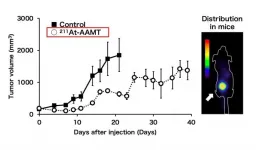Better together: Scientists discover applications of nanoparticles with multiple elements
2021-01-04
(Press-News.org) An emerging type of alloy nanoparticle proves more stable, durable than single-element nanoparticles.
Catalysts are integral to countless aspects of modern society. By speeding up important chemical reactions, catalysts support industrial manufacturing and reduce harmful emissions. They also increase efficiency in chemical processes for applications ranging from batteries and transportation to beer and laundry detergent.
As significant as catalysts are, the way they work is often a mystery to scientists. Understanding catalytic processes can help scientists develop more efficient and cost-effective catalysts. In a recent study, scientists from University of Illinois Chicago (UIC) and the U.S. Department of Energy's (DOE) Argonne National Laboratory discovered that, during a chemical reaction that often quickly degrades catalytic materials, a certain type of catalyst displays exceptionally high stability and durability.
"We have state-of-the-art facilities, and we want to deliver state-of-the-art science as well." -- Argonne scientist Yuzi Liu
The catalysts in this study are alloy nanoparticles, or nanosized particles made up of multiple metallic elements, such as cobalt, nickel, copper and platinum. These nanoparticles could have multiple practical applications, including water-splitting to generate hydrogen in fuel cells; reduction of carbon dioxide by capturing and converting it into useful materials like methanol; more efficient reactions in biosensors to detect substances in the body; and solar cells that produce heat, electricity and fuel more effectively.
In this study, the scientists investigated "high-entropy" (highly stable) alloy nanoparticles. The team of researchers, led by Reza Shahbazian-Yassar at UIC, used Argonne's Center for Nanoscale Materials (CNM), a DOE Office of Science user facility, to characterize the particles' compositions during oxidation, a process that degrades the material and reduces its usefulness in catalytic reactions.
"Using gas flow transmission electron microscopy (TEM) at CNM, we can capture the whole oxidation process in real time and at very high resolution," said scientist Bob Song from UIC, a lead scientist on the study. "We found that the high-entropy alloy nanoparticles are able to resist oxidation much better than general metal particles."
To perform the TEM, the scientists embedded the nanoparticles into a silicon nitride membrane and flowed different types of gas through a channel over the particles. A beam of electrons probed the reactions between the particles and the gas, revealing the low rate of oxidation and the migration of certain metals -- iron, cobalt, nickel and copper -- to the particles' surfaces during the process.
"Our objective was to understand how fast high-entropy materials react with oxygen and how the chemistry of nanoparticles evolves during such a reaction," said Shahbazian-Yassar, UIC professor of mechanical and industrial engineering at the College of Engineering.
According to Shahbazian-Yassar, the discoveries made in this research could benefit many energy storage and conversion technologies, such as fuel cells, lithium-air batteries, supercapacitors and catalyst materials. The nanoparticles could also be used to develop corrosion-resistant and high-temperature materials.
"This was a successful showcase of how CNM's capabilities and services can meet the needs of our collaborators," said Argonne's Yuzi Liu, a scientist at CNM. "We have state-of-the-art facilities, and we want to deliver state-of-the-art science as well."
INFORMATION:
The scientists published a paper on the study, titled "In Situ Oxidation Studies of High-Entropy Alloy Nanoparticles," in ACS Nano.
Co-authors on the paper are Yong Yang of the University of Maryland; Muztob Rabbani, Timothy Yang and Wissam Saidi of the University of Pittsburgh; Kun He, Xiaobing Hu and Vinayak Dravid from Northwestern University; Yifei Yuan of UIC; and Pankaj Ghildiyal and Michael Zachariah of the University of California.
This research was funded, in part, by the National Science Foundation and DOE's Office of Science.
University of Illinois at Chicago Contact:
Jacqueline Carey
UIC Office of Public Affairs
P: (312) 996-8277
jmcarey@uic.edu
About Argonne's Center for Nanoscale Materials
The Center for Nanoscale Materials is one of the five DOE Nanoscale Science Research Centers, premier national user facilities for interdisciplinary research at the nanoscale supported by the DOE Office of Science. Together the NSRCs comprise a suite of complementary facilities that provide researchers with state-of-the-art capabilities to fabricate, process, characterize and model nanoscale materials, and constitute the largest infrastructure investment of the National Nanotechnology Initiative. The NSRCs are located at DOE's Argonne, Brookhaven, Lawrence Berkeley, Oak Ridge, Sandia and Los Alamos National Laboratories. For more information about the DOE NSRCs, please visit https://science.osti.gov/User-Facilities/User-Facilities-at-a-Glance.
Argonne National Laboratory seeks solutions to pressing national problems in science and technology. The nation's first national laboratory, Argonne conducts leading-edge basic and applied scientific research in virtually every scientific discipline. Argonne researchers work closely with researchers from hundreds of companies, universities, and federal, state and municipal agencies to help them solve their specific problems, advance America's scientific leadership and prepare the nation for a better future. With employees from more than 60 nations, Argonne is managed by UChicago Argonne, LLC for the U.S. Department of Energy's Office of Science.
The U.S. Department of Energy's Office of Science is the single largest supporter of basic research in the physical sciences in the United States and is working to address some of the most pressing challenges of our time. For more information, visit https://energy.gov/science.
ELSE PRESS RELEASES FROM THIS DATE:
2021-01-04
A team working with Roland Fischer, Professor of Inorganic and Metal-Organic Chemistry at the Technical University Munich (TUM) has developed a highly efficient supercapacitor. The basis of the energy storage device is a novel, powerful and also sustainable graphene hybrid material that has comparable performance data to currently utilized batteries.
Usually, energy storage is associated with batteries and accumulators that provide energy for electronic devices. However, in laptops, cameras, cellphones or vehicles, so-called supercapacitors are increasingly installed these days.
Unlike batteries they can quickly store large amounts of energy and put it out just as fast. ...
2021-01-04
Forgive Asiatic black bear if they're not impressed with their popular giant panda neighbors.
For decades, conservationists have preached that panda popularity, and the resulting support for their habitat, automatically benefits other animals in the mountainous ranges. That logic extends across the world, as animals regarded as cute, noble or otherwise appealing drum up support to protect where they live.
Yet in Biological Conservation, scientists take a closer look at how other animals under the panda "umbrella" fare and find several species have every reason to be ticked at panda-centric ...
2021-01-04
HOUSTON -- Researchers at The University of Texas MD Anderson Cancer Center have discovered that a protein called NF-kappa B-inducing kinase (NIK) is essential for the shift in metabolic activity that occurs with T cell activation, making it a critical factor in regulating the anti-tumor immune response.
The preclinical research, published today in Nature Immunology, suggests that elevating NIK activity in T cells may be a promising strategy to enhance the effectiveness of immunotherapy, including adoptive cellular therapies and immune checkpoint blockade.
In a preclinical melanoma model, the researchers evaluated melanoma-specific T cells engineered to express higher levels of NIK. Compared to controls, ...
2021-01-04
HOUSTON -- Researchers from The University of Texas MD Anderson Cancer Center who profiled more than 45,000 individual cells from patients with peritoneal carcinomatosis (PC), a specific form of metastatic gastric cancer, defined the extensive cellular heterogeneity and identified two distinct subtypes correlated with patient survival.
Based on their findings, published today in Nature Medicine, the researchers developed and validated a gene expression signature capable of predicting patient survival better than other clinical features. If validated in prospective studies, this tool may be useful in stratifying ...
2021-01-04
EUGENE, Ore. -- Jan. 4, 2021 -- Phosphorous, calcium and charcoal in spotty patches of fertile soil in the Amazon rainforest suggest that natural processes such as fires and river flooding, not the ingenuity of indigenous populations, created rare sites suitable for agriculture, according to new research.
The presence of pre-Columbian artifacts and signs of plant domestication uncovered in the region's fertile soil, commonly called Amazonian dark earth, had been thought to mean that agricultural practices, including controlled burning, by indigenous people had boosted soil nutrients.
However, radiocarbon dating ...
2021-01-04
What The Study Did: Denmark was one of the first countries to enforce lockdown to reduce the spread of COVID-19 and subsequent gradual reopening, whereas Sweden has had few restrictions, largely limited to public recommendations. Researchers assessed public mobility and social media attention associated with COVID-19 spread and societal interventions from February to June in Denmark and Sweden.
Authors: Isabell Brikell, Ph.D., of the Karolinska Institutet in Stockholm, is the corresponding author.
To access the embargoed study: Visit our For The Media website at ...
2021-01-04
What The Study Did: Researchers used health insurance data from Taiwan to investigate the risk of substance use disorder among patients with autism spectrum disorder and its associations with risk of death.
Authors: Chih-Sung Liang, M.D., of the National Defense Medical Center, and Mu-Hong Chen, M.D., Ph.D., of the Taipei Veterans General Hospital in Taipei, Taiwan, are the corresponding authors.
To access the embargoed study: Visit our For The Media website at this link https://media.jamanetwork.com/
(doi:10.1001/jamapediatrics.2020.5371)
Editor's Note: The article includes funding/support disclosures. Please see the article for additional information, including other authors, author ...
2021-01-04
Bitterling fishes (Subfamily: Acheilognathinae) spawn in the gills of living freshwater mussels obligately depending on the mussels for reproduction. On the Matsuyama Plain, Japan, populations of unionid mussels--Pronodularia japanensis, Nodularia douglasiae, and Sinanodonta lauta--have decreased rapidly over the past 30 years. Simultaneously, the population of a native bitterling fish, Tanakia lanceolata, which depends on the three unionids as a breeding substrate, has decreased. Furthermore, a congeneric bitterling, Tanakia limbata, has been artificially introduced, and hybridisation and genetic introgression occur between them. Here, we surveyed the reproduction and occurrence of hybridisation between native and invasive species ...
2021-01-04
Improving solar cell design is integral for improving energy consumption. Scientists have lately focused on making solar cells more efficient, flexible, and portable to enable their integration into everyday applications. Consequently, novel lightweight and flexible thin film solar cells have been developed. It is, however, not easy to combine efficiency with flexibility. For a material (usually a semiconductor) to be efficient, it must have a small "band gap"--the energy required to excite charge carriers for electrical conduction--and should absorb and convert a large portion of the sunlight into electricity. Till date, no such efficient absorber suitable for thin film solar cells has been developed.
Typically, charge carriers in a semiconductor are ...
2021-01-04
Osaka, Japan - A cancer-specific L-type amino acid transporter 1 (LAT1) is highly expressed in cancer tissues. Inhibiting the function of LAT1 has been known to have anti-tumor effects, but there has been limited progress in the development of radionuclide therapy agents targeting LAT1. Now, a multidisciplinary research team at Osaka University has established a targeted alpha-therapy with a novel drug targeting LAT1.
The researchers first produced the alpha-ray emitter 211Astatine, no easy task given that Astatine (At) is the rarest naturally occurring element on Earth. Targeted alpha-therapy selectively delivers α-emitters to tumors; the advantage over conventional β-therapy is that alpha ...
LAST 30 PRESS RELEASES:
[Press-News.org] Better together: Scientists discover applications of nanoparticles with multiple elements





